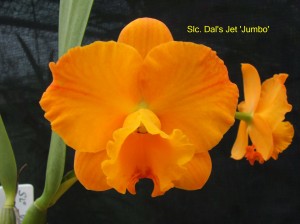[slideshow_deploy id=’757′]
CATTLEYA HYBRIDS
With the advancement of breeding technology since the early sixties, Mericloneing, Storage of Pollen etc., Cattleyas have shown their true worth.
The added colours and combinations of colours is very exciting, I wonder where it will end. Being able to store pollen, we can now have plants that grow all year round and flower two/three times a year. The number of flowers per inflorescence is increasing, so are the number of inflorescences.
This is the life of an orchid from pollen to flowering:
- POD: From pollination to removal is 6 to 8 months
- FLASKING: Mother flask 3 months; replates 14 to 18 months
- COMPOTS: 12 to 18 months; 4” pots 12 to 18 months; some will flower at the end of this period, especially minnie catts. Most of the larger cattleyas will take another 12 months to flower
- POTTING MATERIALS: Sphagnum Moss, Coco Fibre, Perlite, Bark, Charcoal, Peat Moss. These will vary in size to suit the pot size
- REPOTTING: Every two years, except if plant has health problems that need attention.
- WATERING: 1 to 2 days in mid summer; 3 to 4 days in Spring and Autumn; 5 to 7 days in winter. I prefer to water early in the morning, before 7am in summer and 9am in the winter. Do not practice hit and miss watering, keep it regular.
- FERTILIZER: There are so many fertilizers and things written about them, that one has to wonder why everyone doesn’t grow their orchids to perfection. I believe that it comes down to being consistent in what you do. Small Amounts often is far better than big amounts once in a while. I like Scott’s, Seasol, Nitrosol, Campell’s A&B, Molasses. I use a Slow Release fertilizer, Plantacote pluss 14.3.-4-12.5 and micronutrients, 6 months for summer.
- FUNGICIDES: Fosject 400, Antracol, Mancozeb,Ridomil MZ680, Elliette, Alginox, Bravo, Triforine, these are rotated as required.
- INSECTICIDES: Bugmaster, Maldison 500, Confidor,Webzone, Success, Gremlin, Vertimec.
- STERILIZING: I use Trisodium Phosphate, a saturated solution will inactivate viruses in 20 minutes, does not rust your cutters.
- PH. Ph can upset all products used on you plants, that includes Fertilizers, Insecticides and Fungicides. If you are not getting any results when using them, ph is probably the problem. Find out the ph of your water, a good ph is between 5.8 and 6.4, your Council can give you the ph of your water supply. Most Orchid Societies have a PH meter.
![]()
